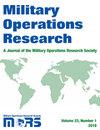氯致哺乳动物死亡数据的回顾和评估以及人类估计R-1的发展
IF 0.3
4区 管理学
Q4 OPERATIONS RESEARCH & MANAGEMENT SCIENCE
引用次数: 12
摘要
摘要:通过对现有哺乳动物致死数据的回顾和统计分析,得出了人类吸入氯致死与暴露时间函数的新估计。需要这样的估计来支持涉及空气中氯释放的风险评估和伤亡预测。目前,对此类泄漏的伤亡预测与历史上观察到的不一致;预测的下风危险区域通常比实际观察到的要大得多。要么是目前对中位致死剂量(LCT50)的估计过低,要么是目前流行的大气输送和扩散(ATD)模型不能充分模拟氯的释放,要么两者兼有。对8种动物(小鼠、大鼠、豚鼠、兔、猫、狗、山羊和绵羊)的LCT50和定量反应数据进行分析,暴露时间为8至235分钟。基数为10的概率斜率(浓度)是通过哺乳动物死亡率研究中实验测量斜率的加权平均值来估计的。由此产生的人体致死率(军事)估计是暴露时间的函数,通过毒性负荷模型表示。一般人口估计是使用Crosier(2007)的数学方法从军事估计中得出的。审查了以前的人类估计数,并将其与新的一般人口估计数进行了比较。通过对一辆油罐车50吨氯的灾难性意外泄漏进行一系列运输和扩散模拟,评估了新估计的影响。下风危险距离的敏感性也作为中位致死毒性负荷(TL)、毒性负荷指数和概率斜率值的函数进行了研究。本文章由计算机程序翻译,如有差异,请以英文原文为准。
Review and Assessment of Chlorine Mammalian Lethality Data and the Development of a Human Estimate R-1
Abstract : New human estimates for chlorine inhalation lethality as a function of exposure duration were derived via a review and statistical analysis of existing mammalian lethality data. Such estimates are needed to support risk assessments and casualty predictions involving airborne releases of chlorine. At present, casualty predictions for such releases are at odds with what has been observed historically; the predicted downwind hazard area has often been much larger than what was actually observed. Either the present estimates for median lethal dosages (LCT50) are too low, the currently popular atmospheric transport and dispersion (ATD) models cannot adequately model chlorine releases, or both.LCT50 and quantal response data were analyzed for eight species (mouse, rat, guinea pig, rabbit, cat, dog, goat and sheep), for exposure durations from 8 to 235 minutes. The base 10 probit slope (concentration) was estimated via the weighted average of experimentally measured slopes in mammalian lethality studies. Resulting human lethality (military) estimates as a function of exposure duration were expressed via the toxic load model. General population estimates were derived from the military estimates using the mathematical method of Crosier (2007). Previous human estimates were reviewed and compared to the new general population estimate. The impact of the new estimate was evaluated through a series of transport and dispersion modeling runs for the catastrophic accidental release of 50 tons of chlorine from a tanker car. The sensitivity of downwind hazard distances was also investigated as a function of median lethal toxic load (TL), toxic load exponent and probit slope values.
求助全文
通过发布文献求助,成功后即可免费获取论文全文。
去求助
来源期刊

Military Operations Research
Engineering-Mechanical Engineering
CiteScore
0.40
自引率
0.00%
发文量
0
期刊介绍:
Military Operations Research is a peer-reviewed journal of high academic quality. The Journal publishes articles that describe operations research (OR) methodologies and theories used in key military and national security applications. Of particular interest are papers that present: Case studies showing innovative OR applications Apply OR to major policy issues Introduce interesting new problems areas Highlight education issues Document the history of military and national security OR.
 求助内容:
求助内容: 应助结果提醒方式:
应助结果提醒方式:


